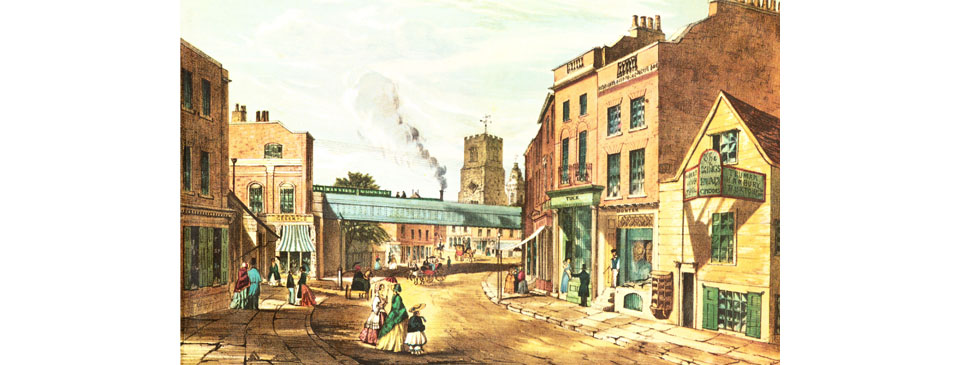In brief – London during the mid-19th century

A train from Camden passes over Mare Street, Hackney on the new North London Railway in this engraving from the early 1850s. The railway was built to provide a link between the London & Birmingham Railway at Chalk Farm and the East and West India Docks. The section through Hackney was completed in 1850 and the entire line opened in January 1852.
The Industrial Revolution and Britain’s increasing international trade required financing and insuring. Wars and political unrest in Continental Europe left London as the safest and most reliable place to invest or raise capital and to store gold and other valuables. During the 19th century the City of London became the unrivalled financial capital of the world. Banking failures in the early part of the century led to the formation of joint-stock banks and the first of these was the London & Westminster, which opened in 1834, followed by London & County, National Provincial, and Barclays.
During the Victorian era the London-based publishing industry came to dominate the news and magazine industry throughout Britain, the Empire and beyond. Like finance, it was on London that much of the world relied for its supply of information: ‘London news’. And like London’s financial industry, the news publishing and distribution business gathered together in one small area of London, in this case around Fleet Street, which had long been a centre for printing and allied trades. By the end of the 19th century printing became one of London’s major industries, with engravers, compositors and lithographers amongst the highest paid workers.
As London’s middle-class population moved out to the suburbs, shopping areas were created in those new districts. Oxford Street, Regent Street, Kensington High Street, Brompton Road, Queensway and Upper Street, Islington were particularly fashionable by the end of the century. It was in such areas that department stores began to grow, often starting from a single shop founded by a dynamic entrepreneur who was able to expand his business either by moving to larger premises or by setting up additional branches.
One of the most fundamental changes to take place to London began from the time that railways first arrived in the capital in 1836. In the following decades companies laid new lines that spread out across the country in every direction. A commission soon determined that the railways should not pass through London and therefore each company created a terminus around the edge of the metropolis as it was at that time. For the first time people from around the country were able to travel to London with relative ease and speed, bringing thousands of visitors flocking to major events.
As the railway system developed, it allowed Londoners to quickly travel from the villages around London into the centre. Once this was possible, those who worked in London and had the financial means began moving out of the centre to live in or near the countryside where housing was cheaper, the air was cleaner, and it was less crowded. A process began where many of the middle-classes moved to new suburbs. They left behind both the upper classes, who anyway had large comfortable homes with servants, and the poorer working classes who did not have the means to move and commute.


